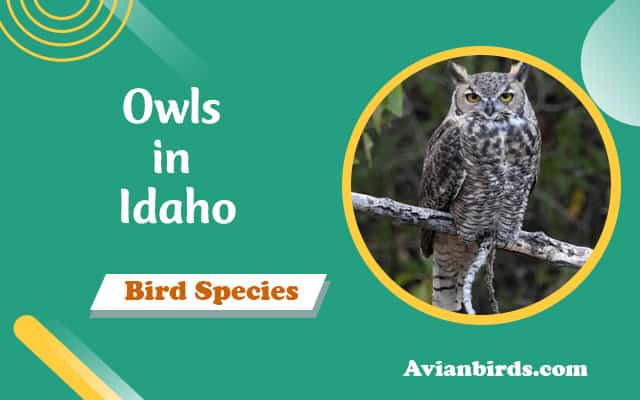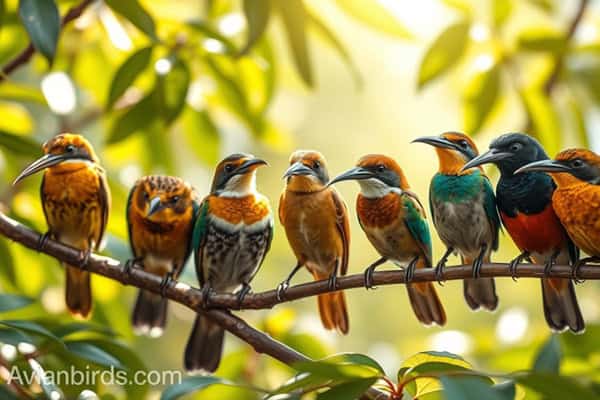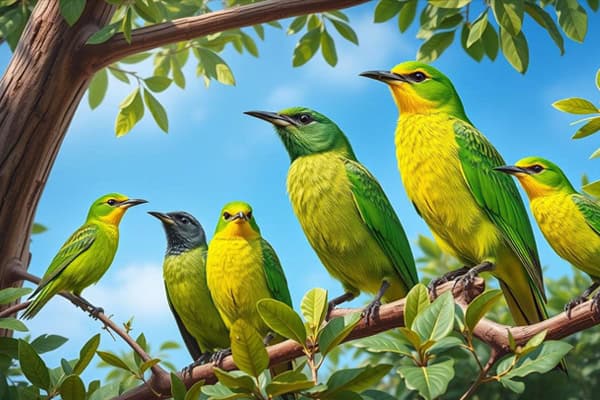9 Types of Owls in Idaho (ID Guide With Pictures)
Owls are amazing birds that live in Idaho. This article explores their fascinating world, focusing on their behaviors, where they live, and how important they are to Idaho’s environment.
Idaho’s wild areas, from thick forests to tall mountains, are perfect for many types of owls. Common owls include the Great Horned Owl, the quiet Barn Owl, and the small Saw-whet Owl. Each type of owl helps keep nature balanced in its own way.
We will look at how these night hunters survive, how they help control rodents, and the problems they face with climate change. Conservation groups are also working hard to protect their homes.
By the end, you will understand why these birds are special and why protecting Idaho’s wildlife is important.
1. Great Horned Owl
- Scientific Name: Bubo virginianus
- Size: 18-25 inches (46-64 cm)
- Weight: 2-5.5 pounds (0.9-2.5 kg)
- Lifespan: 10-20 years in the wild
- Diet: Small mammals, birds, reptiles, and insects
The Great Horned Owl is one of the most powerful and mysterious birds in North and South America. It can be found in many places, from the cold forests of Canada to the warm regions of South America. This owl is easy to recognize because of its large body and the feather tufts on its head that look like horns.
Its feathers are a mix of brown, gray, and white, which helps it blend in with its surroundings. This makes it hard to spot in both forests and open areas. Its intense yellow eyes are unforgettable and show how great it is at hunting, especially at night.

Great Horned Owl: Key Features
- Nests: Unlike many birds, the Great Horned Owl doesn’t build its own nest. Instead, it uses abandoned nests from other large birds. This shows how resourceful and opportunistic the owl is. The nests are usually high in trees, which gives the owl a good view of its surroundings.
- Nesting Behavior: These owls aren’t picky and will take over nests in all kinds of environments, from deep forests to city parks. This adaptability shows how dominant they are among birds.
A Fearless Hunter
The Great Horned Owl is a powerful predator. Its diet includes small animals like mice, rabbits, and other birds, such as hawks and owls. With strong talons and sharp night vision, it hunts with great skill, especially in the dark.
Conservation and Survival
Even though the Great Horned Owl has faced problems in the past, like habitat loss and the use of harmful pesticides, it has proven to be very resilient. Conservation efforts have succeeded largely because these owls can live in many different habitats. Today, conservationists focus on protecting their nests and educating people about how important these birds are to the environment.
2. American Barn Owl
- Scientific Name: Tyto furcata
- Size: 12.6-15.8 inches (32-40 cm)
- Weight: 14-24 ounces (400-700 g)
- Lifespan: 4-5 years in the wild
- Diet: Small mammals, primarily rodents
The American Barn Owl is found across the Americas. It prefers open spaces like farms and grasslands where it can hunt. Its heart-shaped face, pale coloring, and dark eyes give it a ghostly appearance. This owl has a slim body with golden-brown feathers on its back and soft, white feathers underneath, making it stunning to see at night.
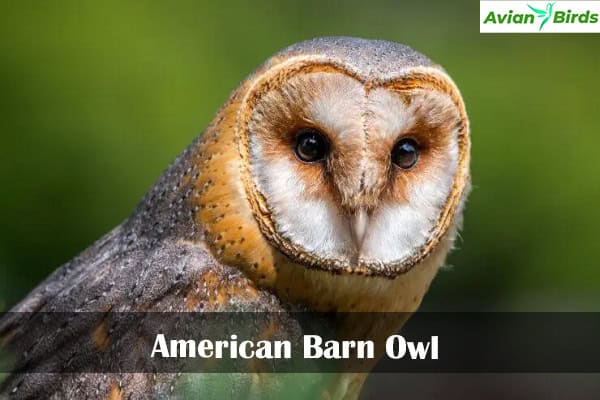
American Barn Owl: Key Features
- Nests: American Barn Owls like to nest in quiet, hidden places such as barn lofts, abandoned buildings, or tree hollows. These secretive spots show their preference for peaceful areas to raise their young, far from human activity.
A Skilled Hunter
American Barn Owls mainly eat rodents, which helps farmers by naturally controlling pests. They hunt silently at night, gliding over fields with incredible accuracy. Their ability to keep rodent populations in check is vital for maintaining balance in their ecosystems.
Conservation Efforts
Conservationists have worked to protect the American Barn Owl by creating safe nesting areas, especially in farming regions. In the past, the loss of barns and farmlands hurt their population. To help, people have set up nest boxes, which these adaptable owls have responded to positively.
3. Barred Owl
- Scientific Name: Strix varia
- Size: 16-25 inches (40-63 cm)
- Weight: 1.6-2.4 pounds (720-1,100 g)
- Lifespan: 10-20 years in the wild
- Diet: Small mammals, birds, reptiles, amphibians, and invertebrates
The Barred Owl lives in dense woodlands across the eastern United States and parts of Canada. It is known for its peaceful beauty and unique “hooting” call, which sounds like a calm southern night.
This owl’s feathers have brown and white stripes, which give it its name. Its round face and dark eyes, like those of many owls, make it look wise and calm.
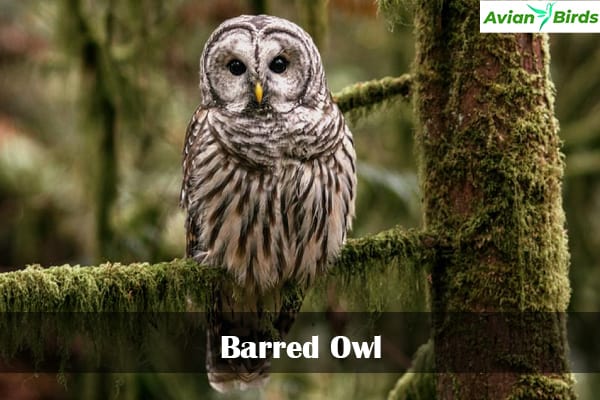
Barred Owl: Key Features
- Nests: Like the American Barn Owl, Barred Owls form lifelong pairs during mating season. Their courtship begins in February, with males spreading their wings to attract females. They build their nests in hollow trees deep in the forest.
A Diverse Diet
Barred Owls eat various animals, mainly small mammals like mice and voles. They also hunt smaller birds, reptiles, and insects. Sometimes, they catch bigger animals like rabbits and squirrels. With excellent hearing, they find their prey near rivers and wetlands. When food is scarce, they can adapt by scavenging.
Population and Conservation
There are around 3 million Barred Owls worldwide, and they are common in North America. The IUCN lists them as “Least Concern.” However, they do face risks from things like polluted prey and the destruction of their forest habitats.
4. Short-eared Owl
- Scientific Name: Asio flammeus
- Size: 13-17 inches (33-43 cm)
- Weight: 7.3-16.8 ounces (206-475 g)
- Lifespan: 4-12 years in the wild
- Diet: Small mammals, primarily voles and other rodents
The Short-eared Owl is a nomadic bird found in open areas across North America, Europe, and Asia. It has a charming look, with brown and buff feathers and small ear tufts that are often hard to see.
Its bright yellow eyes, surrounded by black, stand out against its pale facial disk. With their subtle patterns, the owl’s feathers help it blend perfectly into grasslands and marshes.
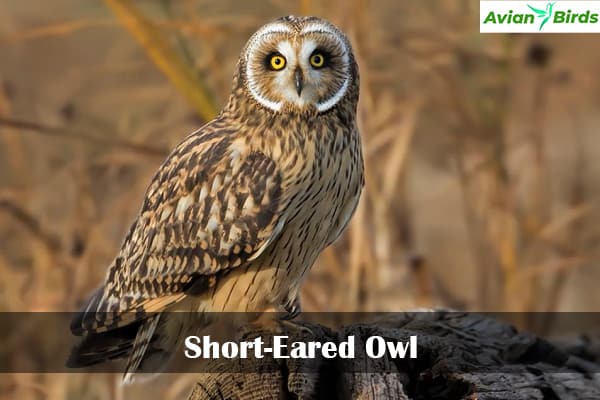
Short-eared Owl: Key Features
- Nests: Short-eared Owls build their nests on the ground, usually in tall grasses of fields and marshes. They are highly adaptable to different landscapes and build simple scrapes in the ground, which demonstrates their rugged and tough nature.
A Daytime Hunter
Unlike many other owls, Short-eared Owls hunt during the day. They mainly eat small mammals found in open fields, like voles and mice. These owls often glide low over grasslands, gracefully searching for prey.
Conservation Efforts
Conservation of Short-eared Owls focuses on protecting the open grasslands they rely on for survival. The expansion of farms and cities has threatened their nesting areas. Conservationists are working to preserve and restore these habitats to ensure the owls have safe places to nest and hunt.
5. Long-eared Owl
- Scientific Name: Asio otus
- Size: 35-40 cm
- Weight: 220-435 grams
- Lifespan: 10-12 years
- Diet: Small mammals, birds, insects
The Long-eared Owl lives in many parts of the Northern Hemisphere and is known for its quiet, graceful movements. As its name suggests, its most noticeable feature is the long ear tufts that stand up when the owl is alert.
This owl has a slim body covered with brown and black feathers that blend in with tree bark. Its bright orange eyes make it look striking, standing out against its natural colors.
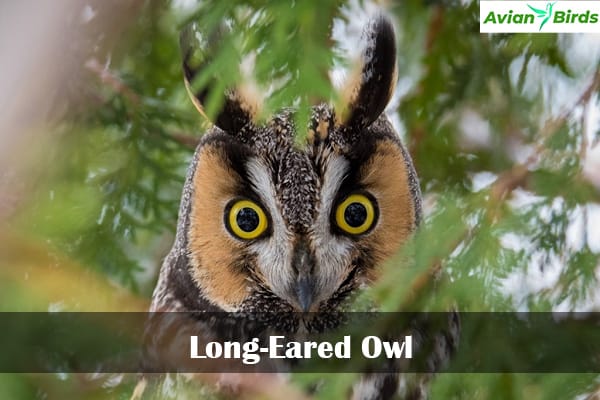
Long-eared Owl Habits
Long-eared Owls usually make their homes in abandoned nests built by other birds, like crows and hawks. They choose dense forests or areas with thick tree cover to stay hidden from predators. The female owl stays in the nest to keep the eggs warm, while the male owl goes out to find food for the family.
What They Eat
These owls mainly eat small rodents like mice, which helps keep rodent populations in check. They are excellent hunters, using their sharp hearing to find prey at night, even in complete darkness.
Protecting the Long-eared Owl
Protecting the places where long-eared owls nest and raise their young is important for their survival. Human activity easily disturbs these birds, so keeping their breeding areas safe from development is key to their conservation.
The Long-eared Owl is a special bird that plays an important role in nature. Protecting its habitat helps ensure its continued success.
6. Northern Saw-whet Owl
- Scientific Name: Aegolius acadicus
- Size: 17-22 cm
- Weight: 54-151 grams
- Lifespan: 7-10 years
- Diet: Small mammals, especially mice and some birds
The Northern Saw-Whet Owl is a small but fascinating bird. Its feathers are a deep brown with white spots, helping it blend in perfectly with the trees. This owl has large, round yellow eyes that stand out on its cute, rounded face, making it quite captivating despite its tiny size.

Northern Saw-Whet Owl Habits
Northern Saw-Whet Owls of Idaho are like to nest in holes in trees, often made by woodpeckers. Sometimes, they also use special nest boxes. The female owl stays in the nest to keep the eggs warm and care for the chicks, while the male brings food for the family.
What They Eat
These owls eat small animals like mice and insects. They hunt at night, using their sharp hearing and vision to find their prey in the dark.
Protecting the Northern Saw-Whet Owl
To protect Northern Saw-Whet Owls, it’s important to care for their habitat and monitor their population. One threat to their survival is the loss of old forests, which are key to their nesting and hunting needs.
7. Burrowing Owl
- Scientific Name: Athene cunicularia
- Size: 19-28 cm
- Weight: 140-240 grams
- Lifespan: 6-8 years
- Diet: Insects, small mammals, birds, and reptiles
The Burrowing Owl is a fascinating bird found in open areas across the Americas, such as prairies and deserts. Unlike most owls, this one lives in burrows on the ground. It has long legs, a body with brown and white spots, and bright yellow eyes. Its round head, which lacks ear tufts, gives it a cute and unique look. The owl’s feathers help it blend in with the dry, scrubby landscape.

Burrowing Owl Habits
Burrowing Owls are different from other owls because they make their homes underground, often in burrows left behind by prairie dogs or ground squirrels. This shows how well they have adapted to life in open grasslands and deserts. Their lively presence brings a sense of energy to these otherwise quiet environments.
What They Eat
Burrowing Owls have a varied diet that includes insects, small mammals, and sometimes small birds. They are opportunistic eaters, meaning they will eat whatever prey is most available. These owls either wait by their burrows for food to come close or chase after it by running on the ground or flying.
Protecting the Burrowing Owl
Conservation efforts for Burrowing Owls are focused on protecting their ground-level habitats. Urban development and farming have taken away many of their burrowing sites. To help, conservationists are working to protect natural burrows and even create artificial ones so these charming birds can continue to thrive in their unique homes.
8. Snowy Owl
- Scientific Name: Bubo scandiacus
- Size: 52-71 cm
- Weight: 1.6-3 kg
- Lifespan: 10-17 years
- Diet: Mainly lemmings, small mammals, birds, and occasionally fish
The Snowy Owl is a majestic bird living in the open, frozen tundra of the far north. It has beautiful white feathers with black spots, making it stand out in its icy surroundings. Its bright yellow eyes are especially striking against its white face, adding to its powerful and captivating look.

Snowy Owl Habits
Snowy Owls build their nests on the ground by making shallow dips in open areas. Unlike many other owls, they don’t nest in trees or on cliffs. The female owl stays on the nest to keep the eggs warm, while the male hunts for food. They prefer to nest in wide, undisturbed areas that resemble the Arctic tundra where they live.
What They Eat
Snowy Owls of Idaho mainly eat small mammals, especially lemmings. They are opportunistic hunters, which means they will eat whatever prey is available, such as rabbits, rodents, and birds. Their hunting style involves sitting on a high spot and waiting patiently before swooping down to catch their prey.
Protecting the Snowy Owl
Conservation efforts for Snowy Owls focus on protecting their habitats, especially their wintering grounds in places like Idaho. The biggest threats to these owls are climate change and human disturbance. Research and monitoring programs are important for tracking their migration and helping create better conservation plans.
9. Northern Hawk-Owl
- Scientific Name: Surnia ulula
- Size: 36-45 cm
- Weight: 300-340 grams
- Lifespan: 10 years
- Diet: Small mammals, birds, and occasionally insects
The Northern Hawk Owl is a fascinating bird found in the boreal forests of Canada and Eurasia. Its long, narrow wings and tail make it look like a raptor or bird of prey. The owl’s feathers are brown with white spots, and its face is framed by a bold black outline around its bright yellow eyes, making it a striking and memorable sight.
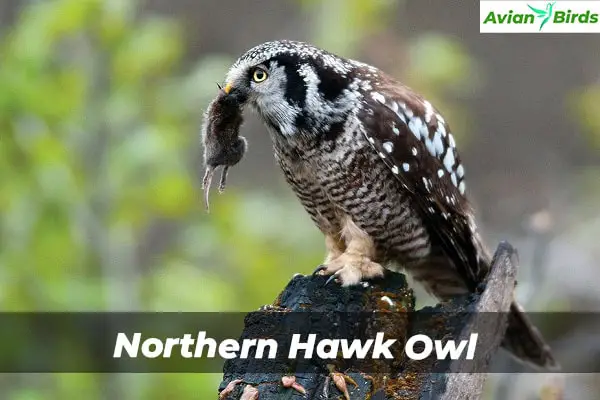
Northern Hawk Owl Habits
Northern Hawk Owls of Idaho prefer to nest in open areas, often choosing tree stumps or old, dead trees. Sometimes, they also use abandoned nests left behind by other large birds. The female owl stays in the nest to incubate the eggs, while the male goes out to hunt and bring food back to the nest.
What They Eat
These owls mostly eat small mammals, especially voles. They are daytime hunters and use a “perch-and-pounce” method, where they sit on a high spot, watch for prey, and quickly swoop to catch it.
Protecting the Northern Hawk Owl
To protect Northern Hawk Owls, it’s important to safeguard the places where they nest and hunt. Logging and development pose threats to their habitats. Research into their population and breeding habits is crucial for creating effective conservation plans.
Read More🦉Related Articles:
- What Do Owls Eat
- Owls in Ohio
- Owls In Oregon
- Owls in New Jersey
- Owls in Minnesota
- Owls in Massachusetts
- Owls In Virginia
Final Words
Owls in Idaho offer a captivating glimpse into the state’s rich biodiversity. Each species contributes uniquely to the ecosystem, from the mighty Great Horned Owl to the elusive Northern Saw-Whet Owl. Birdwatching enthusiasts will find Idaho a treasure trove of owl sightings. Embrace the opportunity to discover these remarkable birds and deepen your appreciation for nature’s wonders. Happy owl spotting! 🦉
Frequently Asked Questions
Q1. Are owls common in Idaho?
Owls are relatively common in Idaho, with several species found throughout the state.
Q2. Where to find burrowing owls in Idaho?
Burrowing owls are often found in open grasslands, agricultural areas, and near prairie dog towns in southern Idaho.
Q3. What bird screeches at night in Idaho?
The common screech owl is known for its distinctive screeching calls at night in Idaho.
Q4. What are the hoot owl restrictions in Idaho?
Hoot owl restrictions in Idaho refer to fishing regulations that limit fishing during certain hours to protect fish populations; typically, they restrict fishing after 2 p.m. on specific waters during low water conditions.

